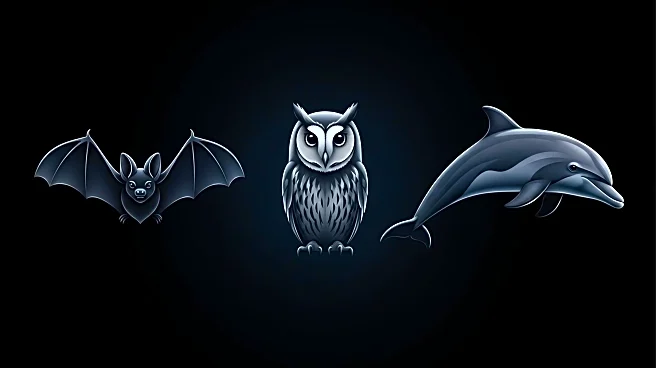What is the story about?
What's Happening?
Recent research highlights the extraordinary hearing capabilities of various animals, including bats, owls, and dolphins. Bats utilize echolocation, emitting high-frequency calls to navigate and hunt in the dark. The greater wax moth can detect these calls, showcasing its ability to hear frequencies up to 300 kilohertz, far beyond human hearing. Barn owls possess a unique auditory system shaped by nocturnal hunting habits, allowing them to pinpoint prey through sound localization. Dolphins, similar to bats, use echolocation to map their surroundings, relying on sound waves to create mental images of their environment. Pinnipeds, such as seals, demonstrate the ability to hear both above and below water, adapting their auditory systems to different environments.
Why It's Important?
Understanding animal hearing capabilities provides insights into evolutionary adaptations and potential applications in technology. The echolocation abilities of bats and dolphins inspire advancements in sonar technology, offering improved imaging techniques. The study of pinnipeds' dual hearing capabilities could lead to innovations in underwater communication systems. Additionally, these findings contribute to conservation efforts by highlighting the importance of preserving habitats that support these specialized auditory systems. Researchers and technologists can leverage these natural adaptations to enhance human-made systems, potentially benefiting industries such as defense, navigation, and environmental monitoring.
What's Next?
Further research into animal auditory systems may uncover additional adaptations and mechanisms, potentially leading to new technological applications. Scientists may explore the genetic basis of these hearing abilities, aiming to replicate or enhance them in artificial systems. Conservationists might use this knowledge to advocate for the protection of habitats critical to species with specialized hearing. Collaborative efforts between biologists and technologists could result in innovative solutions for environmental challenges, utilizing nature-inspired designs to improve human technology.
Beyond the Headlines
The study of animal hearing extends beyond technological applications, offering insights into the ethical considerations of human impact on wildlife. Understanding how animals perceive their environment can inform policies on noise pollution and habitat preservation. Additionally, these findings may influence cultural perceptions of animals, fostering appreciation for their unique adaptations and encouraging conservation efforts. Long-term, this research could shift societal views on the interconnectedness of human and animal life, promoting sustainable practices that benefit both.
AI Generated Content
Do you find this article useful?
















